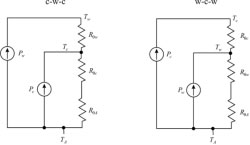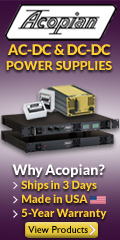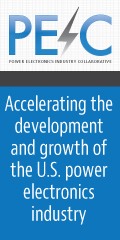 |
|
IN THIS ISSUE:
» Active Clamp Flyback Converters – How They Work And Tips For Design Success
» Base Metal Electrodes Reduce Size And Weight Of MLCCs In Satellites
» Configurable IC Simplifies Conversion Of Temperature To Frequency
» Focus On Magnetics:
How To Thermally Model Magnetic Components
» Spotlight On Safety & Compliance:
Knowing The Link Between Product Regulations And Product Standards Can Put You Ahead Of The Competition
» New Power Products
» Industry Events:
CMSE & WiPDA Asia
» Other Top Power News
From the Editor's Desk David G. Morrison
Editor, HOW2POWER TODAY

The compliance area is full of pitfalls for electronics engineers. There are so many requirements that can potentially impact your product design, reflecting the different areas discussed in our Safety & Compliance column. Even within these areas (safety, EMC, environmental, etc.) there are particular requirements for specific applications, markets or regions and the many requirements are constantly evolving. Making this subject even more confusing, there’s the compliance jargon. Even the meaning of basic terms such as “regulations” and “standards” can be confusing and these terms often get tossed around as though they refer to the same things. But as Arnold Alderman explains in this month’s Safety & Compliance column, there is a difference and it does matter. Moreover, understanding the processes and timing by which regulations and standards are developed can help designers to better navigate the compliance quagmire, understand where to find the information they need to design for compliance and ultimately, how they or their companies can get involved in the regulations development process to gain a competitive edge. This issue also looks at some technical areas where power designers may have opportunities to gain a performance edge by applying a fairly new power supply topology (the active clamp flyback), space-saving capacitors for satellite applications (MLCCs made with base-metal electrodes) and a cost-saving design for temperature measurement (a low-cost temperature-to-frequency converter). In addition, this month’s Focus on Magnetics aims to demystify the task of thermally modeling magnetic components. Plus we have news about CMSE, WiPDA Asia, the latest components and more.
|
|
 |
 |

|
HOW2POWER EXCLUSIVE DESIGN ARTICLES 
|
Active Clamp Flyback Converters – How They Work And Tips For Design Success
by Michael O’Loughlin, Texas Instruments, Manchester, N.H.
In low-power applications (typically 150 W or less), the active-clamp flyback (ACF) converter is becoming a popular choice over the quasi-resonant flyback (QRF) converter. When designed correctly, an ACF topology will have a nearly lossless leakage energy clamp and will be able to achieve zero voltage switching (ZVS) on the primary MOSFET over a wide input voltage and output load range. In low-power applications, it’s possible to design an ACF for power densities as high as 39 W/in3 and with peak efficiencies that exceed 94%.The only problem with ACF is that the topology is fairly new; some designers may not have heard about it, and/or may be reluctant to use it. This article reviews the benefits and operation of an ACF and gives some design guidance and tips on applying it.
Read the full article…
|

Current and voltage waveforms depict
essential elements of ACF timing. |

|

A four-stack BME MLCC for space
applications saves space and weight
versus an equivalent capacitor using
precious metal electrodes (PMEs). |
Base Metal Electrodes Reduce Size And Weight Of MLCCs In Satellites
by John Marshall, AVX, Coleraine, United Kingdom and Ron Demcko, AVX, Fountain Inn, S.C.
The rate of change in the satellite world is accelerating and along with that comes the changes needed for power supplies onboard. This article provides a high-level view of the emergence of base metal electrode (BME) multilayer ceramic capacitors (MLCCs) for satellite applications. After providing some background on MLCCs and the development of their electrode materials, this article describes the advances in component materials, construction and fabrication techniques, and the track record in automotive and other sectors that have proven the reliability of BME MLCCs. Then the size advantages which motivate the use of these capacitors in space are discussed. The rest of this article reviews the reliability studies that AVX has performed to qualify BME MLCCs for space, and the status of space approvals for these capacitors, particularly Mil Prf 32535. Finally, it discusses details of BME capacitor design for space.
Read the full article…
|

Configurable IC Simplifies Conversion Of Temperature To Frequency
by Oleksiy Kravchenko, Dialog Semiconductor, Lviv, Ukraine
Temperature sensors are one of the most important types of physical sensors because many different processes are regulated by temperature. For example, the temperature measurement in a power semiconductor device is necessary to rapidly identify damage to power components—just one of many uses in power electronics. Typically, sensors convert a measured physical value into an analog signal. Then, for processing by a CPU or computer, the analog temperature signal must be converted into a digital form, typically using expensive analog-to-digital converters. This article presents a simplified technique for direct conversion of the analog signal from a temperature sensor into a digital signal with proportional frequency using a GreenPAK configurable mixed-signal IC. Subsequently, the frequency of a digital signal that varies with temperature can then be more easily measured with a fairly high accuracy and then converted to the required units of measurement.
Read the full article…
|

Direct conversion of temperature to
frequency using a configurable mixed-
signal IC is beneficial because it
eliminates the need for expensive ADCs.
|

 |  |

FOCUS ON MAGNETICS 
Sponsored by Payton Planar Magnetics
A monthly column presenting information on power magnetics design, products, or related technology |

How To Thermally Model Magnetic Components
by Dennis Feucht, Innovatia Laboratories, Cayo, Belize
The most difficult aspect of magnetic component design is the quantification of thermal behavior. Core and winding temperatures are the ultimate limitation on how much power can be transferred through a magnetic device, yet to calculate allowable power transfer at maximum design temperatures is challenging. This article surveys some of what is involved in thermal modeling and how to conceptualize it. Read the full article…
|

Core type generally determines magnetic component
configuration to be either core-winding-core
or winding-core-winding, each of which
has its own thermal network model.
|

 |
 |

SPOTLIGHT ON SAFETY & COMPLIANCE 
Sponsored by Power Integrations
A monthly column discussing standards and regulatory requirements affecting power electronics |

Knowing The Link Between Product Regulations And Product Standards Can Put You Ahead Of The Competition
by Arnold Alderman, Maintenance Leader PSMA SCDB and EEDB Data Bases
A regulation is a rule or directive created and maintained by an authority such as a country, federation of countries, states, or provinces. Enforcement is by law. Content is available to the public for free. A standard is a document created by consensus and approved by a recognized body or organization for common or repeated use. Standards may be international or regional. Most standards are available to the public for a fee levied by the organization. Enforcement occurs when a label is attached to the product indicating compliance. Regulations precede and influence certain performance and test standards. This article explains how company standards staff and design engineers can monitor and influence a regulation far in advance of any standard(s) creation thus better positioning their company products for success under the new regulation. Beginning with an historical example, the author chose the European Union (EU) and the relationship between the Ecodesign efficiency regulation and the relevant IEC standard(s). Read the full article…
|

 |
 |

 — POWER PRODUCTS IN 3 IMAGES OR LESS — POWER PRODUCTS IN 3 IMAGES OR LESS 
|

|

Power Integrations’ SIC1182K
SCALE-iDriver SiC-MOSFET gate driver. |
SiC-MOSFET Gate Driver Improves Efficiency And Safety
 Photo: Housed in an eSOP-R16B package, the SiC MOSFET gate driver delivers up to 8 A at a junction temperature of 125°C, allowing it to support SiC-MOSFET inverter designs up to several hundred kilowatts without a booster stage. It also features FluxLink communications technology, which offers reinforced isolation up to 1200 V, and protection circuits that achieve 5-µs shutdown. Photo: Housed in an eSOP-R16B package, the SiC MOSFET gate driver delivers up to 8 A at a junction temperature of 125°C, allowing it to support SiC-MOSFET inverter designs up to several hundred kilowatts without a booster stage. It also features FluxLink communications technology, which offers reinforced isolation up to 1200 V, and protection circuits that achieve 5-µs shutdown.
 Diagram: Typical application circuit. SCALE-iDriver technology minimizes the number of external components that are needed and reduces the BOM. Diagram: Typical application circuit. SCALE-iDriver technology minimizes the number of external components that are needed and reduces the BOM.
See the full story… |


 |

|


Infineon Technologies’ 1200-V
TRENCHSTOP IGBT7 modules. |
IGBT Power Modules Provide Higher Density And Lower Cost For Industrial Drives
 Photo: Packaged in the well-known Easy housing, the 1200-V TRENCHSTOP IGBT7 modules are designed with the same pin out as TRENCHSTOP IGBT4 modules, which eases migration from the older devices. However, the new modules enable a higher output current in the same package, or a similar output current in a smaller package. Photo: Packaged in the well-known Easy housing, the 1200-V TRENCHSTOP IGBT7 modules are designed with the same pin out as TRENCHSTOP IGBT4 modules, which eases migration from the older devices. However, the new modules enable a higher output current in the same package, or a similar output current in a smaller package.
 Table: Key electrical specs for the modules. Table: Key electrical specs for the modules.
See the full story…
|

AVX’s F9H series surface-mount, J-lead
tantalum capacitors.
|
Automotive-Grade Tantalum Capacitors Deliver High Capacitance Per Volume
 Photo: The AEC-Q200-qualified tantalum electrolytic capacitors are said to deliver twice the reliability of standard automotive-grade capacitors and the industry’s highest CV/cc in a high-temperature 1206 tantalum capacitor—10 μF and 16 V. Photo: The AEC-Q200-qualified tantalum electrolytic capacitors are said to deliver twice the reliability of standard automotive-grade capacitors and the industry’s highest CV/cc in a high-temperature 1206 tantalum capacitor—10 μF and 16 V.
 Table: Part numbers and key specs for members of the series. Table: Part numbers and key specs for members of the series.
See the full story…
|

e-peas’ AEM20940 power management IC.
|
PMIC Supports Thermal Energy Harvesting With Low-Voltage Startup
 Diagram: This power management IC is an integrated energy management subsystem that extracts dc power from a thermal electric generator to simultaneously store energy in a rechargeable element and supply the system with two independent regulated voltages. The rechargeable device could be a Li-ion battery, a thin film battery, a supercap or a conventional capacitor. Diagram: This power management IC is an integrated energy management subsystem that extracts dc power from a thermal electric generator to simultaneously store energy in a rechargeable element and supply the system with two independent regulated voltages. The rechargeable device could be a Li-ion battery, a thin film battery, a supercap or a conventional capacitor.
 Photos: A cold start circuit enables start up (with no stored energy available) from an input voltage as low as 100 mV and just 80 µW of input power typ. Photos: A cold start circuit enables start up (with no stored energy available) from an input voltage as low as 100 mV and just 80 µW of input power typ.
See the full story…
|

|






|

 |
 |

INDUSTRY EVENTS  |
|
Components For Military & Space Electronics Explores IC Packaging, Passives And More
The 23rd Annual Components for Military & Space Electronics (CMSE) is the premier event focused on the design, reliability, and application of electronic components for use in avionics aerospace, military and commercial space systems. This year’s conference and exhibition will be held April 16-18 in Los Angeles at the Four Points Hotel at LAX. How2Power.com is a sponsor of this event. The CMSE conference provides access to more than 30 technical presentations by industry leaders, focused on advanced packaging of ICs, passive components, and a number of other topics critical to components used in high-reliability military and aerospace systems. Also included are over 30 exhibitors of passives, semiconductors and equipment manufacturers. The cutting-edge tutorials, along with two days of exhibition and technical presentations, educate, inform, and provide solutions for current challenges within the military and space electronics business. Read the full story…
|

|
|
WiPDA Asia Hosts Distinguished Lineup Of Speakers On WBG Power Technology
The Workshop on Wide Bandgap Power Devices and Applications in Asia (WiPDA Asia), which is sponsored by the IEEE Power Electronics Society (PELS), provides a forum for device scientists, circuit designers, and application engineers to share technology updates, research findings, development experience, and application knowledge. WiPDA-Asia 2019 will be held in Taipei, Taiwan from May 23-25. This year’s workshop will feature more than 10 keynote speakers who are leading experts from academia, industry, and research institutes that will share their insights on technology developments and future trends. There will also be three tutorials on high-voltage and/or high-speed power device development, implementation, and application; and around 50 technical papers presented to share new findings. Read the full story…
|
OTHER TOP POWER NEWS
|
|
 At APEC 2019, the PowerAmerica Institute will share its progress in advancing the development and adoption of wide bandgap (WBG) semiconductor technology in the U.S. The institute has provided about $100 million in funding to more than 120 projects. At APEC 2019, the PowerAmerica Institute will share its progress in advancing the development and adoption of wide bandgap (WBG) semiconductor technology in the U.S. The institute has provided about $100 million in funding to more than 120 projects.
 On March 28, a PELS webinar on “Gallium Nitride Power Devices: Switching Characteristics, Gate Drivers and Applications” will be presented by Han Peng of HUAZHONG University of Science & Technology. On March 28, a PELS webinar on “Gallium Nitride Power Devices: Switching Characteristics, Gate Drivers and Applications” will be presented by Han Peng of HUAZHONG University of Science & Technology.


 The FREEDM Research Symposium, which will be held April 10-12, 2019 in Raleigh, NC, will provide an update on the tech and trends in medium-voltage power electronics, power systems, renewable energy, and electric transportation. The FREEDM Research Symposium, which will be held April 10-12, 2019 in Raleigh, NC, will provide an update on the tech and trends in medium-voltage power electronics, power systems, renewable energy, and electric transportation.
 On April 24, an IAS webinar on “Electrical Safety Prevention through Design—Part 2: the Future is Already Here” will be presented by Marcelo Valdes of ABB. On April 24, an IAS webinar on “Electrical Safety Prevention through Design—Part 2: the Future is Already Here” will be presented by Marcelo Valdes of ABB.
 The Power Stamp Alliance (PSA), which is creating collaborative solutions for 48-V-to-low-voltage on-board dc-dc converters, has announced a software user interface that can be used with any compatible power stamps from PSA member companies. The Power Stamp Alliance (PSA), which is creating collaborative solutions for 48-V-to-low-voltage on-board dc-dc converters, has announced a software user interface that can be used with any compatible power stamps from PSA member companies.
 On May 16, an IAS webinar on “High Efficiency Wireless Charging of Electric Vehicles” will be presented by Chris Mi of San Diego State University. On May 16, an IAS webinar on “High Efficiency Wireless Charging of Electric Vehicles” will be presented by Chris Mi of San Diego State University.
 A report by WIRES finds that the drive towards electrification of transportation and heating in the U.S. will require major new electric transmission infrastructure, projecting that $30-to-$90 billion in investments will be needed by 2030. A report by WIRES finds that the drive towards electrification of transportation and heating in the U.S. will require major new electric transmission infrastructure, projecting that $30-to-$90 billion in investments will be needed by 2030.
|

 |
|  |

 |
|  |
|